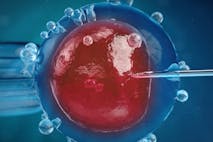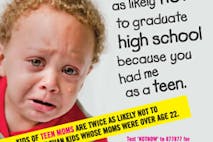
Dismembered infant found in freezer of Tokyo adult entertainment business
Angeline Tan
·
Words that kill
“The baby is incompatible with life. Here is the number if you choose to terminate.”
Until this Summer, I had never heard of Trisomy 18. Also known as Edwards Syndrome, Trisomy 18 is a genetic disorder caused by the presence of an extra 18th chromosome in a person’s cells. This can cause heart malformations, kidney problems, breathing difficulties and a number of other problems. The idea of a genetic disorder was abstract, until Tad, my unborn baby cousin, was diagnosed with T18.
After learning that Tad had T18, doctors quickly changed their tone when talking about him. Despite the fact that some children do survive with the condition, they told his parents that the condition is “lethal” and that the baby is “not compatible with life”. Sometimes subtly, and sometimes bluntly, they urged abortion.
Fortunately for Tad (and his extended family), his parents are not only opposed to abortion, but active in the pro-life movement in their community. But, hearing my aunt and uncle tell about the doctors brought me to an important question: Aren’t we all “incompatible with life”?
Death is faced by every human being — even those with the ideal lives envisioned in the “every child a wanted child” mantra of Planned Parenthood and pro-abort groups. The fact that Tad will one day meet his Creator proves that he is just as alive and human as his born contemporaries. Knowing that this sad day may come sooner, however, is no reason to end his life now.
Quality of Life vs. Life
In discussing Trisomy 13, another type of Trisomy, a 2003 report by the Hastings Center stated,
“Although many of the congenital syndromes that used to be lethal no longer are, they are still routinely referred to as “lethal anomalies.” But the label is not only inaccurate, it is also dangerous: by portraying as a medical determination what is in fact a judgment about the child’s quality of life, it wrests from the parents a decision that only the parents can make.”
Aside from the final statement (that implies one should be able to decide the fate of another), this point is very true — and the same logic applies to Trisomy 18. As anyone involved in the pro-life movement knows, our society repeatedly fails to make the distinction between quality of life, and life itself.
Article continues below
Dear Reader,
Have you ever wanted to share the miracle of human development with little ones? Live Action is proud to present the "Baby Olivia" board book, which presents the content of Live Action's "Baby Olivia" fetal development video in a fun, new format. It's perfect for helping little minds understand the complex and beautiful process of human development in the womb.
Receive our brand new Baby Olivia board book when you give a one-time gift of $30 or more (or begin a new monthly gift of $15 or more).
In the past few decades, science has progressed drastically. We can know the gender, size, health, and even face of our baby before they make their birthday debut. With 4-D ultrasounds, we don’t have to wait nine months to see if Baby has “Daddy’s nose.”. Yet, with all of these advancements, there is one thing science has yet to create: There is no “quality-of-life meter.” Nor will there ever be.
We all have that friend who takes pride in their refined taste for something. Perhaps a friend believes his opinions on movies are unsurpassed, or another claims she can distinguish a perfect brew of coffee. Humanity is very gifted at comparing the values of various objects, but we must not carry over that pride into the judgment of life. We don’t get to be life connoisseurs, claiming to know what life is worth trying — and what life is not. Children with disabilities will know life differently than you and I, but their lives are not worth less than our own.
Lethal Language
The failure to distinguish between quality of life, and life itself, moves from frustrating to dangerous when doctors advising mothers miss the distinction as well. Life is lethal, not my cousin. Pressuring a mother to end the life of her own child, however, is lethal and absolutely unacceptable.
I have been unable to find statistics specific to the Trisomy 18 abortion rate, but a more common form of Trisomy, Trisomy 21 (Down Syndrome), has an abortion rate of about 90% upon diagnosis. I would assume the Trisomy 18 rate is higher, as the condition is more life-threatening.
As pro-life individuals, we need to be aware of these dangerous labels for two reasons. First, as with any abortion, we need to have compassion for women and families who have fallen victim to this harmful rhetoric and opted for abortion. Even friends who identify as pro-life could have a hard time knowing where they stand when given such a manipulated diagnosis. In the midst of the trauma and emotion of an unexpected diagnosis, one could easily be swept away by the suggestions of “professionals”. Second, we need to be prepared when friends are faced with similar circumstances, and ready to help clarify the distinction between quality of life and life itself.
My family is not disillusioned into thinking Tad will live a struggle-free life, but for now we are thankful for him as he is. Let us inform our society about the value of every human life, and help put aside this dangerous, lethal language.
Live Action News is pro-life news and commentary from a pro-life perspective.
Contact editor@liveaction.org for questions, corrections, or if you are seeking permission to reprint any Live Action News content.
Guest Articles: To submit a guest article to Live Action News, email editor@liveaction.org with an attached Word document of 800-1000 words. Please also attach any photos relevant to your submission if applicable. If your submission is accepted for publication, you will be notified within three weeks. Guest articles are not compensated (see our Open License Agreement). Thank you for your interest in Live Action News!

Angeline Tan
·
Guest Column
Emily Berning
·
Opinion
Nancy Flanders
·
Opinion
Mark Wiltz
·
Opinion
Mark Wiltz
·
Pop Culture
Madison Evans
·
Opinion
Lucy LeFever
·
Opinion
Lucy LeFever
·
Opinion
Lucy LeFever
·
Opinion
Lucy LeFever
·
Politics
Lucy LeFever
·